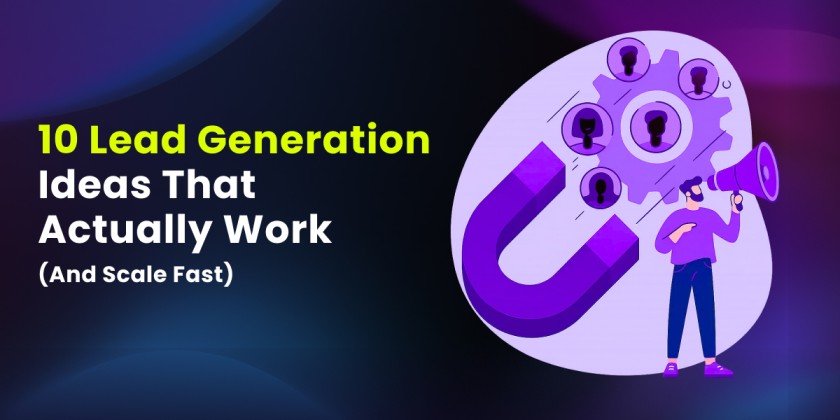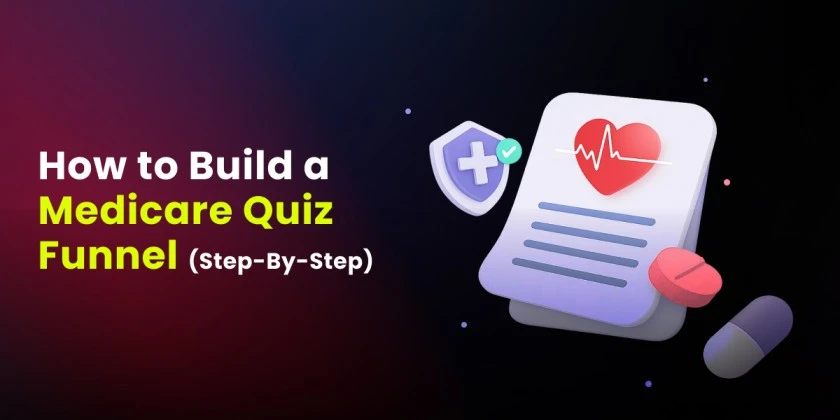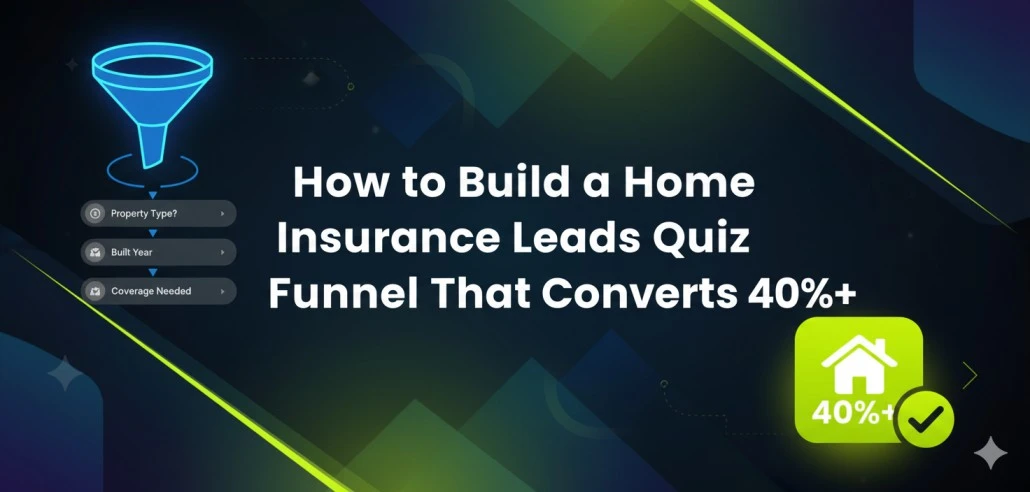If you treat every lead the same way, you’re leaving serious opportunities on the table. Some people are just starting to learn who you are. Others are ready to buy today. Many are somewhere in the middle, weighing their options. Being able to tell the difference between various types of leads is what separates struggling teams from those who consistently crush their goals.
The good news is that you don’t have to guess. Understanding where someone is in their journey means you can easily meet them with the right message at the right time. That also means less wasted effort, more meaningful conversations, and a whole lot more closed deals. A good way to do this is by using a lead capture landing page that aligns with each lead stage.
In this guide, we are breaking down every major type of lead in lead generation you’ll encounter. We will cover how they find you, their engagement level, their readiness to buy, and how to move them forward with an effective lead generation strategy.
Whether you’re setting up your first real sales funnel or fine-tuning a machine that is already running strong, this is your ultimate cheat sheet for turning curiosity into customers and conversations into wins.
Let’s explore who’s filling your funnel and how to maximize every opportunity.
Key Takeaways
- Comprehensive lead classification matters:
Understanding the 26 types of leads across 7 major categories provides you with an organized approach to identify, prioritize, and categorize leads in your pipeline in a more personalized and effective way. - Match your approach to lead stage:
Different sales leads require different tactics, educational content for top-funnel prospects versus personalized demos for purchase-ready opportunities. Recognizing where someone sits in your sales funnel prevents wasted efforts and improves conversion rates. - Engagement signals drive prioritization:
Focus your sales team’s time on highly-engaged hot leads while nurturing colder prospects with automated touchpoints. Consistent interaction is the strongest predictor of conversion potential. - Acquisition source reveals intent:
Inbound leads seek solutions on their terms and respond best to consultative approaches, while outbound leads need relationship-building before serious consideration. - Buying intent trumps demographics:
A prospect requesting pricing information is more valuable than one who simply “fits” your ideal customer profile. Prioritize leads showing clear buying signals regardless of whether they match every targeting criterion. - Lead qualification is continuous:
Successful sales teams reassess lead status based on new behavior signals rather than treating qualification as a one-time event.
Types of Leads based on Funnel Stage
Not every lead is at the same point in their decision-making journey, and treating them all the same is a fast way to lose momentum. Sorting leads by funnel stage helps you match your messaging and offers to what they actually need right now.
Whether they’re just realizing they have a problem or they’re ready to sign on the dotted line, knowing their stage helps you meet them where they are and keep things moving in the right direction.
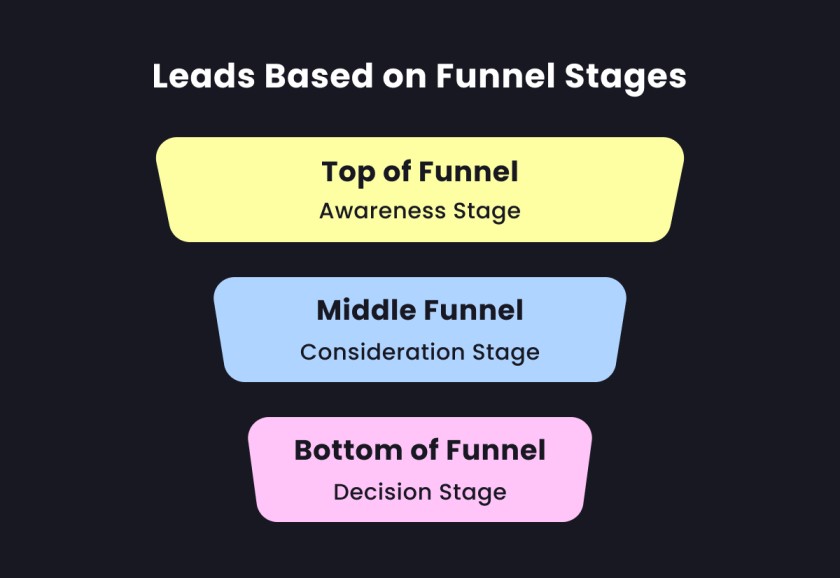
1. Top of Funnel (TOFU) Leads
TOFU leads are at the awareness stage; they’ve just discovered your brand or content and are far from making a purchase decision. These are often the result of marketing campaigns designed to cast a wide net: think blog traffic, social media reach, and downloadable content like checklists or eBooks.
Key Types:
- Awareness stage leads:
People who are just realizing they have pain points or needs but haven’t begun exploring solutions yet. - First-touch leads:
These are brand-new contacts who’ve just interacted with your company for the first time (e.g., visited your site or downloaded a free resource). - Discovery leads:
Individuals discovering your brand via organic search, social media platforms, or shared content they likely fit your target audience but have little brand familiarity. - Initial interest leads:
They’ve taken a minor action (e.g., joined a newsletter or downloaded a guide) but haven’t shown buying intent.
How to handle TOFU leads: The goal is education and trust-building. Offer high-value, problem-solving content guides, blog posts, industry reports, and provide gentle next steps like newsletter sign-ups or webinar invites. Don’t use sales pitches yet.
2. Middle of Funnel (MOFU) Leads
MOFU leads are in the consideration stage. They’re already familiar with your brand and are weighing their options. They’re showing interest and staying engaged, but they’re not quite ready to chat with the sales team or seal the deal just yet. A little more nurturing will help get them there.
Key Types:
- Consideration stage leads:
Leads comparing different solutions to their problem, and weighing pros and cons. - Engaged leads:
Individuals who have repeatedly interacted with your content opened several emails, attended webinars, and downloaded multiple resources. - Interested leads:
Leads who’ve shown deeper interest (e.g., requested a product sheet, read a case study) but haven’t contacted sales yet. - Evaluation stage leads:
They’re beginning to assess whether your solution is a fit, perhaps by reading reviews or comparing features.
How to handle MOFU leads: Focus on solution-based content: case studies, product comparisons, FAQs, and ROI calculators. Use email marketing campaigns and retargeting ads to keep them engaged. A soft call to action, like free trials or consultation, can be effective here.
3. Bottom of Funnel (BOFU) Leads
BOFU leads are at the decision stage; they’re evaluating final options and are close to making a purchase. These leads often become sales qualified leads (SQLs) and are considered purchase-ready. At this stage, they’ve moved beyond general interest and are weighing pricing, features, and terms.
Key Types:
- Decision stage leads:
Leads making their final choice often requesting demos, free trials, or proposals. - Sales qualified leads (SQLs):
Leads that marketing and sales have vetted as ready to engage with a sales rep. - Purchase-ready leads:
People who’ve requested pricing, contacted sales, or shown clear buying intent. - Hot leads:
High-intent leads taking actions like requesting a quote, starting a free trial, or asking about timelines for implementation.
How to handle BOFU leads: This is your closing opportunity. Focus on fast, personal follow-ups with tailored demos, custom pricing, and success stories that hit home.
Show them exactly how you solve their pain points and make it easy to move forward, whether that’s through onboarding support, simple contracts, or a time-sensitive offer.
Types of Leads Based on Acquisition Method
How a lead first encounters your brand says a lot about their mindset and motivation. Leads generated inbound are usually seeking answers and solutions on their terms, while outbound leads are introduced to your brand through proactive outreach.
Then there’s the hybrid mix, where touchpoints blend across channels. Recognizing the acquisition method gives you insight into how leads perceive your brand, how much nurturing they’ll need, and how best to engage them from the start.
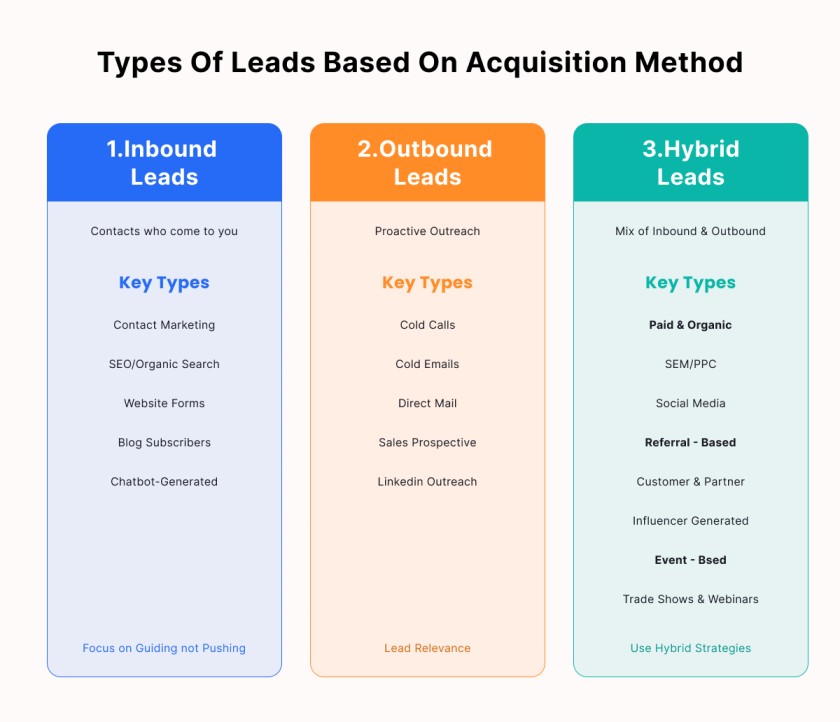
1. Inbound Leads
Inbound leads are contacts who come to you and are attracted by your marketing efforts. They’ve found your brand organically or through helpful content, and they initiate the first interaction.
Key Types:
- Content marketing leads:
Prospects captured through blog posts, guides, videos, webinars, or podcasts that educate and attract audiences. - SEO/organic search leads:
Visitors who find your website through search engines and engage with your content without paid ads. - Website form submission leads:
Individuals who fill out forms to download resources, subscribe, or request more information. Creating high-converting landing pages is crucial here. You can use tools like LanderLab, which offer hundreds of templates specifically designed for lead generation. - Blog subscriber leads:
Users who sign up to receive your content updates or newsletters. - Chatbot-generated leads:
Leads captured through on-site chatbots that answer questions, offer resources, or book meetings.
Pro Tip: Treat inbound leads like a guest who knocked on your door warmly, but without overwhelming them. Focus on guiding rather than pushing. Ask questions to uncover what sparked their interest and where they are in their buying journey.
2. Outbound Leads
Outbound leads are generated through proactive outreach. Instead of waiting for prospects to find you, your team initiates contact through various lead generation techniques and channels.
Key Types:
- Cold call leads:
Prospects contacted via phone without prior interaction, based on targeted lists or prospecting databases. - Cold email leads:
Leads reached through outbound email campaigns offering insights or consultation. - Direct mail leads:
Contacts engaged through physical mail campaigns like brochures or catalogs, especially effective in B2B or localized targeting. - Sales prospecting leads:
Individuals identified and contacted directly by your sales reps. - LinkedIn outreach leads:
Prospects engaged through connection requests, InMail, or social selling.
Pro Tip: The secret to great outbound is making it feel inbound. Lead with relevance. Show you understand their world before talking about your solution. A strong outbound approach starts with listening, not using aggressive sales pitches.
3. Hybrid Inbound-Outbound Leads
Some leads are generated through a blend of inbound attraction and outbound effort, combining proactive outreach with voluntary engagement.
a. Mixed Paid Advertising & Organic Promotion
These leads find you through a mix of paid ads, SEO, and social posts. They’re warm, but their readiness depends on what pulled them in.
- SEM/PPC leads: Ads actively push your message (outbound), but prospects choose to click (inbound).
- Social media marketing leads: Includes a mix of paid ads, organic posts, and community engagement, where promotions drive exposure and interactions build trust.
- Remarketing/retargeting leads: Previous visitors targeted again through strategic ads to re-engage their interest.
b. Referral-Based
These leads arrive with built-in confidence from trusted recommendations. You still have to sell them, but you’re starting way ahead.
- Customer referrals: Leads referred by satisfied customers are one of the highest-converting lead sources.
- Partner referrals: Prospects recommended by business partners or technology alliances.
- Employee referrals: New leads brought in from internal networks and personal connections.
- Affiliate program leads: Leads generated through affiliate marketers promoting your brand for a commission.
- Influencer-generated leads: Followers directed to your brand via influencers endorsing your product or service.
c. Event-Based
Whether it’s a webinar, conference, or local meetup, these leads connected with your brand during an event. They’re curious and engaged but require quick follow-up.
- Trade show/conference leads: Contacts gathered during industry events where you showcase your brand or network face-to-face.
- Webinar attendees: Registrants or attendees of educational webinars who’ve shown interest in your topics.
- Workshop participants: Prospects who’ve engaged through hands-on learning sessions, often showing strong pre-sales interest.
- Meetup attendees: Local or niche event participants interested in your field or industry.
- Product demo attendees: Individuals who’ve attended live or virtual product demonstrations, often signaling buying intent.
Pro Tip: Hybrid leads deserve hybrid strategies. Don’t treat them like a pure cold lead or assume they’re fully warmed up. Acknowledge their early engagement, but still invest time in discovery.
Look for clues in how they interacted with your brand and personalize your approach accordingly, showing attention builds instant credibility.
Types of Leads based on Engagement Level
Engagement is one of the clearest signals of lead quality. Simply put, the more someone interacts with your brand, the more likely they are to buy.
Categorizing leads by engagement level helps you prioritize outreach, tailor messaging, and invest energy where it matters most. Whether a lead is cold, warm, or hot, your strategy should reflect their current level of connection to your business.
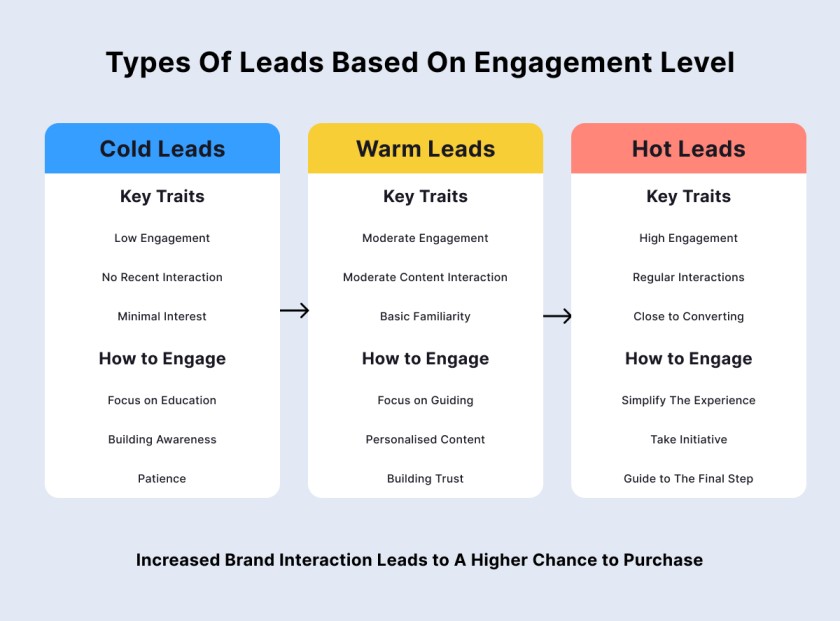
1. Cold Leads
Cold leads are those distant blips on your radar. They might’ve stumbled upon your brand once or twice but haven’t shown much real interest yet. Not all leads are created equal, and cold leads require significant nurturing.
Key Traits:
- Low engagement:
They’ve had minimal interactions, if any. - No recent interaction:
They may have engaged once long ago and gone quiet. - Minimal interest shown:
No significant behaviors like clicking links or asking questions. - Limited knowledge of products/services:
They barely know what you offer or why it matters.
How to engage cold leads: Patience and relevance are your best friends. Your first goal is not to sell but to spark curiosity. Use helpful, educational content to create an early touchpoint.
Personalize outreach based on anything you know about them. Consistency matters more than speed here. A proper lead generation process acknowledges that cold leads need time.
2. Warm Leads
Warm leads are on your radar, and you’re on theirs. While they’ve shown curiosity and interacted with your brand, they’re not really ready to buy yet. Learning how to convert warm leads into sales qualified leads is a crucial skill.
Key Traits:
- Moderate engagement:
Opened emails, clicked links, maybe even attended a webinar, or downloaded a lead magnet. - Some interaction with content/brand:
They’ve interacted a few times across different touchpoints. - Demonstrated some interest:
They’ve explored product pages, case studies, or FAQs. - Basic familiarity with offerings:
They know who you are and what you do, but might still be exploring alternatives.
How to engage warm leads: Timing is everything. Focus on nurturing, not rushing. Send personalized content that deepens their understanding and keeps you top-of-mind.
Ask questions that help qualify their needs and build trust. A well-timed, pressure-free offer to help can quickly turn a warm lead hot.
3. Hot Leads
Hot leads are your fast-track prospects. They’re actively engaging, asking questions, comparing solutions, and ready to move toward a purchase decision.
Key Traits:
- High engagement:
Multiple website visits, repeat email interactions, social media comments, chatbot conversations. - Regular interactions:
Actively seeking information and showing interest in the company’s offerings. - Strong interest signals:
Actions like requesting a demo, pricing information, or scheduling a meeting. - Clear understanding of value proposition:
They know how your solution fits their needs, and they like what they see. - Near purchase decision:
They’re in the final stages of vendor selection or internal decision-making.
How to engage hot leads: Remove friction and make the next steps easy. Be proactive with personalized recommendations. Anticipate objections and be ready with helpful answers.
Hot leads do not want to be sold to; they want to be helped across the finish line. Treat every interaction like it matters because, at this stage, it really does. Your ability to convert hot leads will significantly enhance your overall sales performance.
Types of Leads based on Qualification Status
Before a lead makes it to your sales team or even deeper into your funnel, they need to be vetted. Categorizing leads by qualification status ensures that your teams are speaking with the right people at the right time.
Whether a lead is freshly marketing-qualified, sales-approved, or product-validated, clear qualification stages keep your pipeline healthy, your handoffs smooth, and your closing rates high.
Read more about how to qualify leads in this guide.
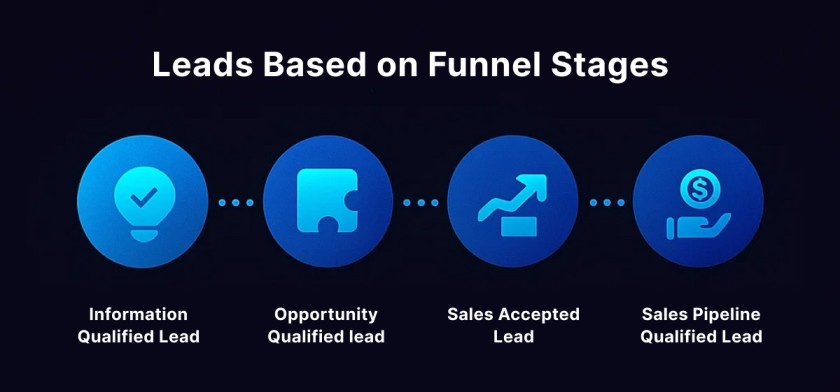
1. Information Qualified Leads (IQLs)
Information qualified leads (IQLs) are at the very beginning of the buyer’s journey. They’ve shown just enough interest to provide their contact information, but they’re still far from making a decision.
Key Traits:
- Provided contact information:
They’ve filled out a form, subscribed to a newsletter, or downloaded a free resource. - Basic qualification only:
At this stage, you know little more than their name, email, and maybe a job title or company name.
Next step: Focus on educating and nurturing these leads without overwhelming them. Deliver valuable content that answers their early questions and positions your brand as a trusted guide.
The goal is to keep them engaged as they recognize problems your product can solve. A strategic approach to convert information-qualified leads into marketing-qualified leads is essential for long-term pipeline health.
2. Marketing Qualified Leads (MQLs)
Marketing qualified leads (MQLs) are those who’ve engaged meaningfully with your marketing efforts and show early signs of buying potential.
Key Traits:
- Shown interest through marketing activities:
Downloaded a lead magnet, subscribed to your blog, or attended a webinar. - Meet basic demographic/firmographic criteria:
Fit your ideal customer profile (industry, job role, company size, etc.).
Next step: Continue nurturing with relevant, personalized content to guide them further down the funnel toward a sales handoff. Your lead generation efforts should consistently produce high quality marketing qualified leads to keep your pipeline healthy.
3. Opportunity Qualified Leads (OQLs)
OQLs have moved beyond casual interest. They’re now actively evaluating potential solutions and engaging in conversations that hint at a real opportunity.
Key Traits:
- Actively evaluating solution:
They’re looking at your product as a serious option. - Engaged in sales conversations:
They may have responded to outreach, attended a demo, or asked in-depth product questions.
Next step: Schedule discovery calls, send surveys, or ask qualifying questions to better understand their specific needs, timeframes, and obstacles. Customize your marketing messages to demonstrate how your solution directly addresses their pain points.
You’re not closing yet; you’re just setting the stage for a high-value conversation that feels natural when they are ready to take the next step.
4. Product Qualified Leads (PQLs)
Product qualified leads (PQLs) are the gold standard for product-led growth companies. These are leads who’ve experienced real value from your product, often through a free trial or freemium version.
Key Traits:
- Experienced product value through trial/freemium:
They’ve signed up and actually used the product. - Reached usage milestones indicating conversion potential:
Completed key actions like setting up an account, using core features, or hitting engagement thresholds.
Next step: Focus on timely, usage-based nudges like upgrade prompts or personalized onboarding, that make the jump to paid seamless and logical. Lead scoring can be particularly valuable for identifying product-qualified leads with the highest conversion potential.
5. Service Qualified Leads (SvQLs)
Service Qualified Leads are a unique breed; they’re existing customers who’ve shown interest in upsells, add-ons, or cross-sells.
Key Traits:
- Current customers interested in additional services/products:
They’ve asked about new features, higher-tier plans, or expanded support. - Identified by customer service teams:
Often flagged during support calls, success check-ins, or usage reviews.
Next step: Treat these leads with care. They already trust your brand, so focus on value expansion and tailored recommendations to deepen the relationship.
6. Sales Accepted Leads (SALs)
A Sales Accepted Lead (SAL) is a lead that both marketing and sales agree is worth pursuing, giving the green light for closer sales follow-up.
Key Traits:
- Passed from marketing to sales:
After initial nurturing, marketing believes the lead is ready for a deeper conversation. - Meets initial sales criteria:
They fit basic qualification benchmarks like company size, role, industry, or budget range.
Next step: Set up a clear, personalized outreach strategy. Make it easy for them to engage further by offering valuable next steps like a customized demo, a strategy session, or a tailored proposal.
Internally, ensure smooth handoffs between marketing team and sales team to keep the momentum strong.
7. Sales Pipeline Qualified Leads
Sales Pipeline Qualified Leads are now officially part of your sales pipeline and are being actively worked toward closing.
They have been vetted and approved by the sales team. They’re no longer just interested; they’re seen as viable opportunities. Converting qualified leads at this stage is crucial for revenue growth.
Key Traits:
- Verified by sales team as potential customers:
Sales has determined there’s a real fit and a real opportunity. - Meet BANT criteria:
They have the Budget, Authority, Need, and Timeline to make a buying decision. - Added to formal sales pipeline:
They’ve been assigned to a sales rep with clear next steps. - Actively working through sales process:
They’re advancing through stages like needs analysis, proposal review, or negotiation.
Next step: Shift into consultative selling mode. Prioritize relationship-building, answer objections, and guide them toward a decision.
Your sales cycle with sales qualified leads (SQLs) should be efficient and well-defined to convert sales qualified leads into customers. These are your highest-conversion opportunities, so treat every interaction like it directly impacts your bottom line because it does.
Want to guide each lead type to the right landing page?
Types of Leads based on Buying Intent
At the end of the day, not every lead has the same urgency or reason for engaging with you. Categorizing by buying intent helps you understand where a lead’s head (and heart) is.
Are they casually researching? Comparing vendors? Ready to purchase? Knowing this lets you customize your content, offers, and conversations to match their intent, creating a more natural and persuasive buying journey.
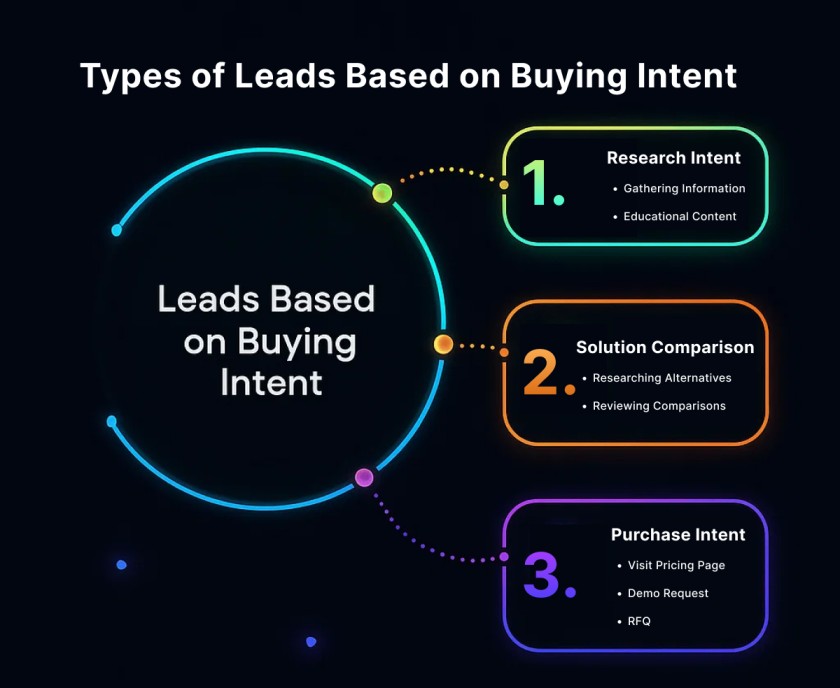
1. Research Intent Leads
Research intent leads are in the information-gathering phase. They’re not ready to buy yet, but they’re starting to recognize a problem or explore opportunities.
Key Traits:
- Information gathering stage:
They’re reading blogs, downloading ebooks, and attending educational webinars. - Educational content consumers:
Their focus is on learning, not yet making a decision.
Next step: Position yourself as the helpful expert they’ll remember when ready to act. Offer educational resources without pushing for a sale. Be present, helpful, and consistent. Build credibility now to increase your chances of becoming their first call when they approach a buying decision.
2. Solution Comparison Leads
These leads have graduated from research into active evaluation mode. They’re weighing options, and you’re in the running.
Key Traits:
- Actively researching alternatives:
They’re reading product comparison guides, checking reviews, and attending demos. - Consuming comparison content:
They engage with content like side-by-side comparisons, case studies, feature lists, and buyer’s guides.
Next step: Make it easy for these leads to see why you are the best choice. Provide clear comparisons, case studies, and address common objections. Responsiveness and transparency are crucial. Position yourself as the trusted partner who understands their specific needs.
3. Purchase Intent Leads
Purchase intent leads are at the finish line. They’ve done their research and are ready to take serious buying actions.
Key Traits:
- Pricing page visitors:
They’re reviewing cost structures and packages. - Demo/trial requesters:
They want hands-on experience to validate their choice. - RFP/RFQ submitters:
They’re formally requesting proposals or quotes, clear signs of imminent buying decisions.
Next step: Move quickly and remove barriers to purchase. Offer a clear next step and reinforce their decision with reassurance around outcomes and value. Make it easy for them to say yes and feel great about it.
Types of Leads based on Sales Cycle Position
Leads rarely follow a straight path from first contact to final purchase. Some move quickly through your pipeline, while others pause along the way or even disappear before coming back.
Sorting leads by their current position in the sales cycle helps your team gain key insights to use the right strategies at the best times. This approach helps you get the timing right, keep momentum going, and prevent valuable opportunities from being missed or lost.
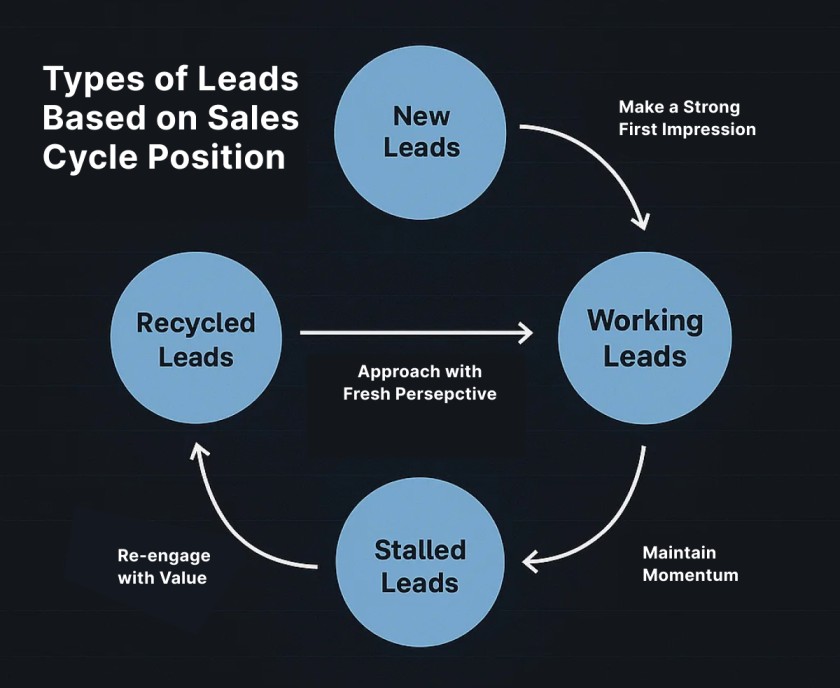
1. New Leads
New leads are fresh additions to your database who’ve just shown interest and are entering initial qualification steps.
Key Traits:
- Recently entered database:
Captured through forms, events, campaigns, or outbound efforts. - Initial qualification stage:
Yet to be fully evaluated for fit, interest level, or buying intent.
Next step: Make strong first impressions. Acknowledge their interest quickly and personalize outreach by referencing how they found you. Offer immediate value with helpful resources and clearly outline potential collaboration.
Being attentive and professional early can quickly transform a new lead into a promising opportunity.
2. Working Leads
Working leads are actively moving through nurturing or direct sales activities with steady engagement and progress.
Key Traits:
- Active in nurturing or sales process:
Receiving drip emails, participating in discovery calls, or attending demos. - Regular engagement:
Consistent interactions through various communication channels.
Next step: Maintain momentum through responsiveness and clarity. Make each next step obvious, whether it’s a follow-up call, demo, pricing discussion, or contract review. Add value during check-ins rather than simply asking for updates. Stay close, helpful, and organized to prevent deals from slipping away.
3. Stalled Leads
Sometimes, despite your best efforts, leads go quiet or pause during the sales process.
Key Traits:
- Paused in sales process:
Stopped responding to emails, no-shows for calls, or postponed decision-making. - Temporarily unresponsive:
May still be interested, but other priorities have taken over.
Next step: Don’t let them disappear silently. Re-engage with new information, fresh offers, or thoughtful follow-ups.
A well-timed case study, market update, or conversation about evolving needs can reignite interest. Focus on reopening dialogue without pressure, and be ready to adjust your approach.
4. Recycled Leads
Recycled leads prove that not every “no” is forever. These were previously disqualified or stalled leads who have re-engaged with your pipeline.
Key Traits:
- Previously disqualified but re-engaged:
Perhaps due to timing, budget changes, or evolving needs. - Returned to pipeline:
Now showing renewed interest and ready for further nurturing.
Next step: Approach with a fresh perspective. Start by requalifying them to understand what’s changed and how your solution fits their current situation.
Bring renewed energy to conversations, focusing on solving present challenges rather than revisiting past discussions.
Turning Lead Insights into Real Revenue Gains
Every lead brings different interest levels, urgency, and trust. The teams that win are not the ones who push harder at every turn, but those who listen, adapt, and stay ahead.
This is where real momentum comes from. Not from treating leads like a checklist, but from building real, responsive conversations that benefit both sides. Understanding what kind of lead you’re working with improves your numbers and creates a system that respects buyers, values your team’s time, and sets you up for sustainable growth.
The smartest move you can make? Stay curious. Pay attention to the signals. Keep adjusting. The sales process isn’t static, and neither are the people you’re selling to.
Meet them where they are, use appropriate lead generation tools, personalize your approach, and categorize sales leads effectively. Watch how quickly the right deals start moving your way.
By implementing these insights, your team can collect leads more efficiently, nurture them appropriately, and ultimately generate more leads that convert. With a strategic approach to lead generation, you’ll not only attract more leads but better quality leads that are more likely to become loyal customers.
Want more leads from your traffic?
Capture every lead type effectively with LanderLab, the landing page builder made for lead generation campaigns.

